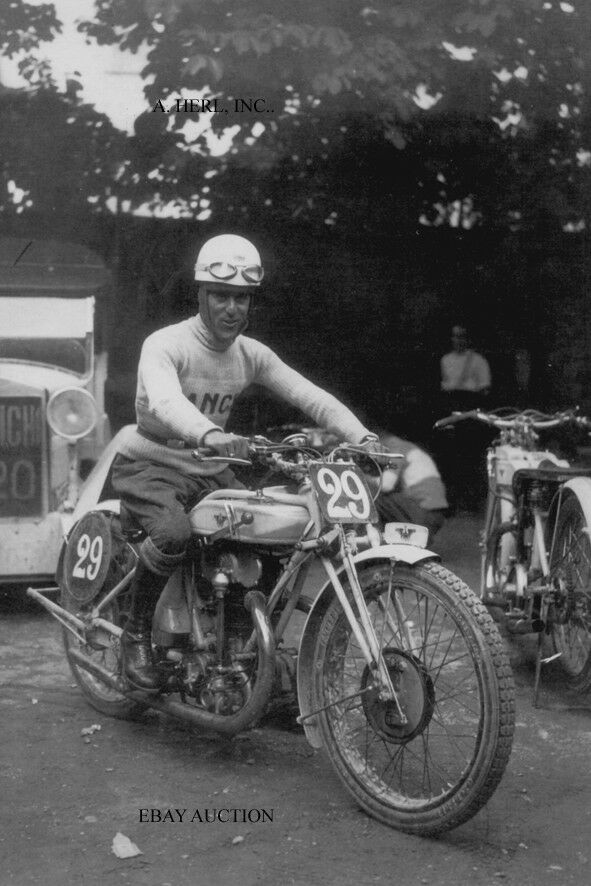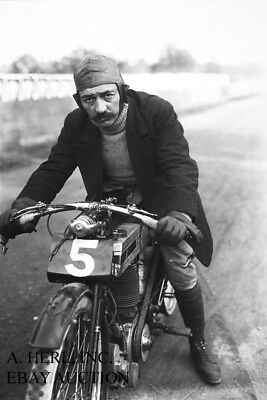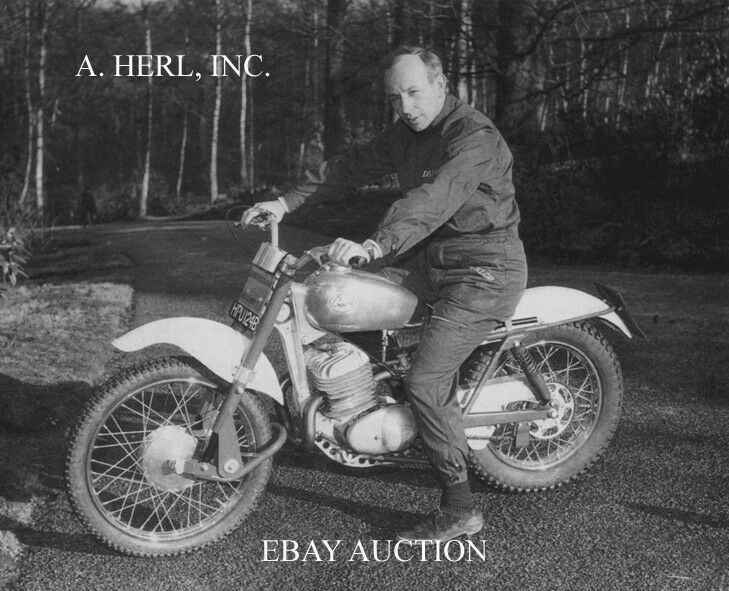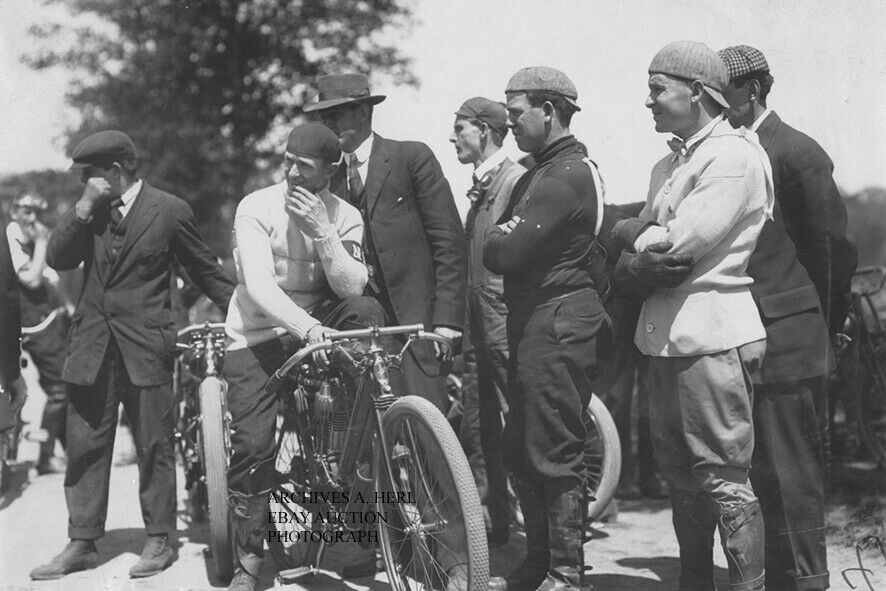-40%
AJS 7R BSA Goldstar Norton Manx start 1955 350cc Ulster Grand Prix motorcycle
$ 5.14
- Description
- Size Guide
Description
A superb and rare photo of the start of the350cc
Ulster
Grand Prix
which was ridden on
August 11, 1955
.
Shown is a very interesting mix of bikes and riders. With number 58 we see G.A. Murphy from
New Zealand
with his
350 A
.J.S. 7R
. Left on the photo, with number 60, we see the very young and famous current museum owner Sammy Miller with his
350cc Norton 40M Manx
and behind the AJS of Murphy, with number 39, we see C. Stormont with his
350cc BSA Goldstar
!
The three greatest British machines of the 1950s are captured in one photograph, we consider this image very unique!
The
350cc AJS 7R
was produced from 1948 to 1963 by Associated Motor Cycles (AMC). It quickly became known as the “Boy Racer”. At first it was a factory racer, but soon it went on to win races for privateers when made generally available from
1954. A
new design by Phil Walker, the chain-driven overhead camshaft 7R had the history of the pre-war AJS ‘cammy’ singles behind it. Initially, the 7R was not as powerful as its competitors, producing 32 bhp (24 kW) at 7500 rpm. The duplex frame and Teledraulic front forks remained relatively unchanged during production, while the engine had a number of changes. The included valve angle was progressively narrowed, and the crankshaft strengthened. In 1956 the engine dimensions changed from the original long-stroke 74 x
90 mm
to the ‘squarer’ 75.5 x
78 mm
. The AMC gearbox replaced the older Burman in
1958. In
1951 AJS development engineer Ike Hatch developed a 75.5 mm bore x
78 mm
stroke, three valve head version of the 7R making 36 bhp (27 kW). It was called the AJS 7R3, and was Ike's response to the Italian multi-cylinder racers. They did well enough in their first year, not as well the second. For 1954 Jack Williams, the works team manager, developed the bike further, lowering the engine in the frame, and making some tuning changes that gave 40 bhp (30 kW) at 7800 rpm. It immediately won the first two rounds of the World Championship and took first at the Isle of Man TT. AJS 7Rs won the 1961, 62 and 63 Junior Manx TT races and came second in 1966. The 1957 AJS 7R 350 cc, with 75.5 mm bore and
78 mm
stroke, gave 38.5 bhp (28.7 kW) at 7600-7800 rpm, and weighed
285 lb
(
129 kg
). The top speed was 180-
190 km/h
(115-
120 mph
). AMC withdrew from the world of works, and one-off, road racing at the end of the 1954, with the death of Ike Hatch, and in the face of fierce competition from the other European bikes. After this AJS made a production version of the standard two valve AJS 7R, for privateers and a 500 cc version, badged as a Matchless G50 was also sold. By the end of production in 1963 the two valve OHC AJS 7R engine made over 40 bhp (30 kW).
The
Norton Manx 30M (500cc)
and
Norton Manx 40M (350cc) Manx
have a very interesting history. Even though Norton had pulled out of racing in 1954, the Manx would remain the backbone of privateer racing for years to come. It was developed to win the Isle of Man TT from single overhead cam international racers by Norton racing team engineer Joe Craig. The double overhead cam configuration was developed in 1937 and after many problems perfected one year later. The Manx was delayed by the outbreak of World War II but reemerged for the 1946 Manx Grand Prix. The motorcycle was upgraded with new telescopic forks and in 1948 gained twin leading shoe brakes. In 1950 the innovative Featherbed frame was developed, giving the Manx a significant competitive advantage through a low centre of gravity and short wheelbase that was perfectly suited the challenging island TT course. The all-welded, tubular featherbed frame was light and trim, without the usual forgings that added unnecessary weight. In 1950 the featherbed Manx recorded a double hat-trick of podium positions at the TT. The Manx engine was redesigned in 1953 with a much shorter stroke of
86 mm
x 85.6 mm to improve the rev range. 1962 was the last full year for the production Norton Manx. In July AMC announced the transfer of production from Bracebridge Street to Woolwich in London. 42 Manx Nortons were produced between November 1962 and January
1963. In
1966 Colin Seeley purchased what remained of the spares and tools and which he eventually sold on to John Tickle in 1969. John Tickle took over the Manx name when Norton ceased production and acquired a large quantity of spare parts. He also manufactured complete racers, called the Manx T5 (500) and T3 (350). Both used the short-stroke Manx engines in a frame designed by Tickle but he could not compete against the Japanese racers and sold his stock and the rights in the late 1970s. The stock was bought by Unity Equipe who produce specialist spares and have a complete Triton cafe racer build to order service. In 1994 Andy Molnar purchased the rights to the Manx name and some original tools and spares from Unity Equipe and the Norton Manx is now in complete production again. In January
1961 a
new Norton Manxman 650cc was launched for the American market only. British racer Les Archer worked with frame specialist Ron Hankins and engine tuner Ray Petty to develop a Manx Norton motocross motorcycle. The double-overhead-cam, short-stroke Norton Manx road racing engine was fitted into a Hankins frame and finished with an aluminum tank and titanium axles. The Manx MX was successful, winning the
1956 F
.I.M. 500cc European Motocross Championship, but not able to compete with the emerging two-stroke bikes. Manx Nortons also played a significant role in the development of post war car racing. At the end of 1950, the English national 500 cc regulations were adopted as the new Formula 3. The JAP Speedway engine had dominated the category initially but the Manx was capable of producing significantly more power and became the engine of choice. Many complete motorcycles were bought in order to strip the engine for 500 cc car racing, as Nortons would not sell separate engines. Manx rolling chassis were frequently sold on and paired with Triumph 500cc twin engines to create Triton cafe racers.
The
BSA Gold Star
was produced between 1938 and 1963. It was made in a 350cc and a 500cc version and it wrote history in the 1950s, when it was one of the fastest and best handling riding machines of the 1950s. These motorcycles were popular for their high performance. Besides being hand built, with many optional performance modifications available, they came from the factory with documented dynamometer test results, allowing the new owner to see the horsepower produced. In 1937, Wal L. Handley lapped Brooklands at over
100 mph
(
160 km/h
) on a BSA Empire Star, and was awarded one of the traditional Gold Star pins for the feat. That inspired BSA to produce the BSA Gold Star. The first Gold Star was an M24. It had an alloy 496 cc engine, an Electron alloy gearbox, and a light tube frame devoid of side-car lugs. This model continued up till the War. After the war the all alloy 348 cc B32 Gold Star was released, with a very large list of optional components. Once ordered the bike was assembled by hand, and the motor bench tested. They were
20 lb
(9.1 kg) lighter than the comparable cast iron barrel and head B series single. They were very successful in the 350 class from 1949 to 1956. They could be specified in tourer, trials, ISDT, scrambles, racing or Clubmans trim. The ZB is taken from the beginning of the engine number. ZB is actually 1949, YB is 1948. The 499 cc B34 Gold Star had a modified crankshaft and a different design main bearing. The 350 continued. In 1950 both received larger front brakes. In 1952 the 500 gets a new Bert Hopwood design head, and the 350 had a new head of that design the following year. In
1953 a
swing-arm duplex frame is introduced, along with an improved gearbox. An optional CB motor was given more and squarer finning, stronger crank, a shorter conrod, oval flywheels (500), improved valve gear, and an Amal GP carb. The DB Gold Star had an improved oil feed to the crankshaft, and finned front brakes. If the buyer specified Clubman cams and timing, he also received a special silencer. At the end of this year the BB and CB models were discontinued. The most prized model was the 500 cc DBD34 introduced in 1956, with clip-on handlebars, finned alloy engine, polished tank,
36 mm
bell-mouth Amal carburettor and swept-back exhaust. The DBD34 had a
110 mph
(
177 km/h
) top speed. The Gold Star dominated the Isle of Man Clubmans TT that year. Later models had a very high first Gear, enabling
60 mph
(
97 km/h
) plus before changing up to second. Production ended in 1963. Towards the end the Gold Star was only offered in scrambles, or Clubmans trim. In 1963 Lucas ceased to produce the magneto used in the B series, and that line of singles was ended. A sporting single was not produced again till the BSA B50 models that were produced from 1971 through 1973. Some remaindered stock were marketed in 1974 as Triumphs, and later CCM used BSA B50 bottom ends in their early specials.
This is a very nice and very rare non period photo that reflects a wonderful era of 1950s motorcycle history in a wonderful way. This is your rare chance to own this photo, therefore it is printed in a nice large format of ca. 8" x 12" (ca. 20 x
30 cm
). It makes it perfectly suitable for framing!
Contact us for more motorcycle photos of the old and famous American and European motorcycle brands and save on shipping!
Shipping costs will only be $ 7.00 regardless of how many photos you buy. For 5 or more photos, shipping is free!
(Note: A. Herl, Inc. does not appear on photo, for ebay purposes only)
No copyright expressed or implied. Sold as collectable item only. We are clearing out our archives that we have gathered from various sources.
All items always sent well protected in PVC clear files
and board backed envelopes.
We have photographs that came from professional collections and/or were bought from the original photographer or press studio! They are all of professional and excellent quality.
After many decades of professionally collecting photographs and posters we are clearing out our archives. They make the perfect gift and are perfectly suited for framing. They will look gorgeous unframed and will be a true asset nicely framed with a border. They are a gorgeous and great asset in every home, workshop, workplace, restaurant, bar or club!
First come - first served. And you can always contact us for your requests. Please ask any questions before the auction ends.









